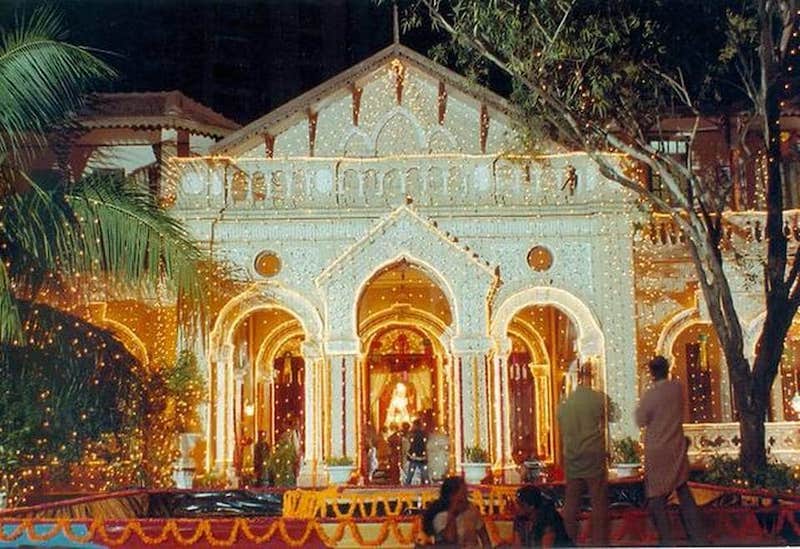Mumbai: G
(Created page with "{| class="wikitable" |- |colspan="0"|<div style="font-size:100%"> This is a collection of articles archived for the excellence of their content.<br/> Additional information ma...") |
|||
| Line 14: | Line 14: | ||
[https://www.thehindu.com/entertainment/movies/mumbais-gulshan-mahal-indian-cinemas-new-address/article26017783.ece Aditya Anand, Mumbai’s Gulshan Mahal, Indian cinema’s new address, January 17, 2019: ''The Hindu''] | [https://www.thehindu.com/entertainment/movies/mumbais-gulshan-mahal-indian-cinemas-new-address/article26017783.ece Aditya Anand, Mumbai’s Gulshan Mahal, Indian cinema’s new address, January 17, 2019: ''The Hindu''] | ||
| + | [[File: Gulshan Mahal- Mumbai (Honey).jpg|Gulshan Mahal- Mumbai; <br/> Picture courtesy: Honey <br/> From: [https://www.thehindu.com/entertainment/movies/mumbais-gulshan-mahal-indian-cinemas-new-address/article26017783.ece Aditya Anand, Mumbai’s Gulshan Mahal, Indian cinema’s new address, January 17, 2019: ''The Hindu'']|frame|500px]] | ||
''The heritage building is now all set to begin life as the National Museum of Indian Cinema'' | ''The heritage building is now all set to begin life as the National Museum of Indian Cinema'' | ||
Latest revision as of 07:35, 18 January 2019
This is a collection of articles archived for the excellence of their content. |
[edit] Gulshan Mahal
[edit] 2019/ refurbished as the National Museum of Indian Cinema (NMIC)
Aditya Anand, Mumbai’s Gulshan Mahal, Indian cinema’s new address, January 17, 2019: The Hindu

Picture courtesy: Honey
From: Aditya Anand, Mumbai’s Gulshan Mahal, Indian cinema’s new address, January 17, 2019: The Hindu
The heritage building is now all set to begin life as the National Museum of Indian Cinema
Gulshan Mahal, the elegant 19th-century heritage bungalow in South Mumbai, was once known for qawwalis and cultural gatherings. Now it is all set to re-enter public life in a new avatar – as the home of the National Museum of Indian Cinema (NMIC).
The fully refurbished building comprises of five floors and two mezzanine floors. An evacuee property, the Peddar Road structure has been refurbished by the government-owned NBCC (India) Ltd at a cost of ₹140.61 crores.
The bungalow, originally known as Gulshan Abad (garden of prosperity), was built in the mid-1800s. It was owned by Peerbhoy Khalakdina, a Gujarati businessman from the Khoja Muslim community. The house, where he lived with his wife and son, was in a wooded five-acre property between Peddar Road and Warden Road, overlooking the Arabian Sea.
Over the years, Gulshan Mahal has been put to different uses by the government. It has served as a hospital for soldiers, was a temporary campus for Jai Hind College, has housed the offices of the Documentary Films of India and the Films Division, and has also been rented out for film shoots like Munnabhai MBBS.
Modernised with the idea of turning the entire complex into a ‘film hub’, the NMIC has been well equipped with state-of-the-art facilities, including expansive auditoriums and a multi-purpose hall that could be used as a movie preview theatre or a seminar hall.
In carrying out this project, NBCC had to contend with the challenge of working in a congested area with barely any working space. Another major constraint was the restricted working hours and regulated sound levels. The entry for heavy vehicles was also restricted during day time. Given these challenges, NBCC adopted an unconventional method of construction, using pre-fabricated structural steel and deck sheets to form a composite structure. “Keeping sustainability in mind, we have also incorporated amenities such as a sewage treatment plant and a water management system, said an NBCC spokesperson.
The new museum building has four exhibition halls, whose themes are Gandhi and Cinema; Technology, Creativity and Indian cinema; Cinema across India; and a Children’s Film Studio. The museum displays will also showcase a hundred years of Indian cinema, with separate sections for The Origin of Cinema, Cinema comes to India, Indian Silent Film, Advent of Sound, The Studio Era, The impact of World War II, Creative Resonance, New Wave, and Beyond and Regional Cinema.